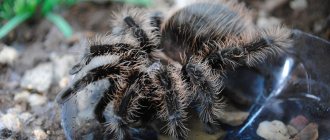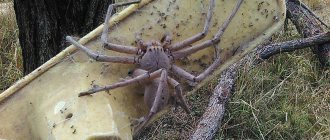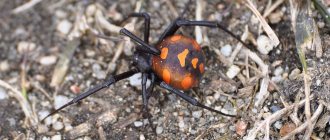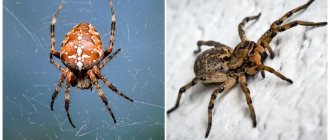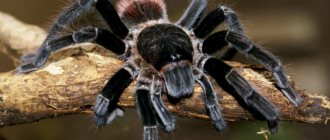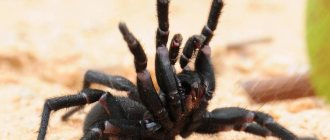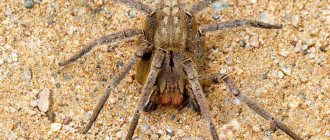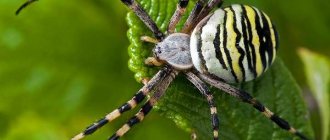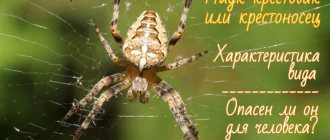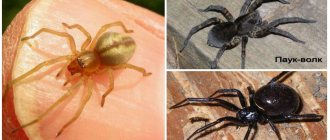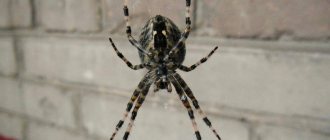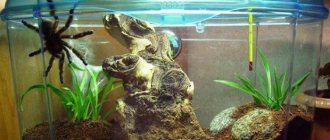On planet Earth, a large number, simply huge, of different amazing creatures live next to each other. Living organisms on earth live in water, on land, fly through the air, live and crawl underground.
Many people are afraid of spiders; they believe that they are mysterious representatives of the animal kingdom. Many people think that this is an insect, because in appearance it is very similar to them. However, let's figure out if this is really the case and who they really are.
Scientists say the first spiders appeared about 390 million years ago. Spiders supposedly originated from a crab-like creature. Science today numbers more than 41,000 species of spiders.
Comparison
Today there are about 42 thousand species of spiders on Earth. They are distributed everywhere. Apart from the jumping spider, all other animals of this order feed on other animals - insects, other spiders or small animals.
Insects are ubiquitous. To date, more than a million species have already been discovered, described and studied.
The spider's body consists of two sections - the cephalothorax and abdomen. Both parts are connected by a thin, short stem. On the cephalothorax there is a groove separating the head and chest parts. It is from the spider’s cephalothorax that the chelicerae “grow”—the spider’s two- or three-membered oral appendages with ducts of poisonous glands—and the entire “magnificent eight” of seven-membered legs. In the cephalothorax there are nerve nodes that form the central nervous system, brain and sensory organs, represented by simple eyes. Sensory hairs that detect odors and sound waves are located on the segments of the legs.
The body of insects consists of three sections - head, thorax and abdomen. On the head they have complex-faceted or simple eyes, antennae and mouthparts - sucking, gnawing, licking or piercing. The six segmented legs of insects are attached to the thoracic region of the body. In some subclasses of insects, a pair of wings also “grows” from the chest.
In the abdomen of the spider there is a heart that drives hemolymph, “book lungs”, a digestive gland, Malpighian glands, gonads and a spinning apparatus. Thanks to the glands located in it, the spider produces a web. Half of its chemical composition is the protein fibrin.
In the abdomen of the insect there are Malpighian vessels, genital organs with a diverse set of copulatory apparatus, which in some orders sometimes plays the role of a sting.
External structure of an insect using the example of a bee
Spiders catch their food using a web and inject poison (digestive juice) into it. After waiting several hours for the poison to dissolve the internal contents of the victim, the spider sucks out this nutrient solution using a sucking-type mouth opening located at the top of the tubercle between the chelicerae.
Insects are omnivores, they eat plants, animals, devour corpses, and are characterized by cannibalism.
Female spiders are in most cases larger and more colorful than males. Often, after mating, spiders eat their males. The color of all types of spiders uses only two color pigments - bilin and guanine.
In insects, sexual dimorphism and sexual polymorphism are noted - two types of females in bees, three types of males in stag beetles. The life cycle of insects is characterized by metamorphism, in which the animal goes through the stages of larva, pupa and adult. Insects can jump, fly, swim, live underwater, and glow in the dark. They are able to communicate using sounds and have the ability to excellently navigate in space.
Spiders and insects: representatives of the phylum arthropods
The differences between small creatures that have several pairs of legs are reflected in the classification adopted in zoology.
Insects belong to the class of the same name called arthropods. Spiders belong to the class Arachnida and the same phylum as insects. You should know that arachnids include not only spiders, but also ticks and scorpions. But between these animals there is a significant difference in body structure and behavior. Today there are more than forty thousand species of spiders on the planet. They can be found almost everywhere. Almost all spiders feed on other living organisms, such as insects. But the insects themselves can be seen in all corners of the Earth. And the number of their species that have been classified and described in science is about a million.
The science that studies insects is called entomology. Another branch of scientific knowledge is devoted to arachnids - arachnology.
Of course, both arthropods differ from each other in the structure of their internal organs. But the structure of the organisms of these little ones is quite complex, so it will not be easy for a person who is not a specialist in the field of biology to understand the fundamental differences between a spider and, for example, an ant. Therefore, the most reliable way to determine who you met on a forest path is by characteristic external signs.
Conclusions TheDifference.ru
- The number of insect species exceeds the number of spider species.
- Spiders have 8 legs, insects have 6.
- The body of spiders consists of two sections, while that of insects has three.
- Only spiders are capable of producing webs.
- Spiders produce venom that is intended for external digestion.
- The life cycle of insects involves transformations - metamorphism; spiders do not have this phenomenon.
- The nervous system, behavior and communication of insects are much more complex than those of spiders.
What class do spiders belong to?
The answer to the question: “Is a spider an insect?” taxonomy gives. What class do spiders belong to? Is a spider an insect or not?
Despite the presence of common characteristics, spiders and insects previously belonged to different classes: arachnids (Arachnida) and insects (Insecta). In modern taxonomy, two classes of insects have been identified: cryptomaxillary and open-jawed, combined into one superclass - six-legged (Hexapoda). The class Arachnida stands apart. Is a spider an insect? The answer is no. However, how is it different from insects?
Ticks
Representatives of the order live not only in the environment, they can live in the body of an animal or human, in soil, and plants. Many of them harm agriculture, destroying cultivated plants. Ticks are also dangerous for humans, as they cause various diseases - scabies, encephalitis. But there are types of mites that are beneficial. These are mainly those that live in the soil. With the help of waste products, they fertilize it and participate in the process of formation of fertile soil.
Fig.3. Types of arachnids
Source: obrazovaka.ru
Other differences
Nature did not provide spiders with ears; instead, they have hairs on their legs that can very accurately determine air vibrations and the location of the source. To sense odors, they also have special hairs and also on their paws. The structure of the eyes and visual acuity depend on the habitat and lifestyle of the arachnids, but the production of cobwebs is carried out with the help of special glands.
The eight-legged one is able to eat a torn web and reproduce it again, and for this it has specially produced enzymes.
Reproduction occurs mainly by laying eggs, from which ready-made spiderlings hatch. Many insects have an endocrine and reproductive system, testes and spermatogenesis; they go through several stages of development and parasitize other species to feed their offspring.
As for the sense organs, they have mechanoreceptors, including sound and photoreceptors, and some insects have chemo- and photoreceptors.
Perhaps spiders and insects originally represented one branch of evolution. For example, arachnids can also weave a web (thread). But it was the tracheal-breathers who became the real masters of the Earth, although some of their species were also dead-end and we learned about them from the only specimen found or fossil remains.
Interesting facts about spiders
Unusual facts about spiders will amaze many who do not yet know about these creatures. But they conceal many mysteries, secrets, and have unique features that other organisms living on the globe do not have.
Let's look at 15 interesting facts about spiders:
- The web is not only a trap for insects, it is capable of deflecting several millimeters in order to grab and stick an insect to itself. This phenomenon is carried out due to a static charge, which appears during the flight of the insect.
- The bite of the Brazilian wandering spider is not always fatal, but it often causes impotence in men.
- With the help of its limbs, the spider can determine what has reached it in the web. But edible or inedible helps him establish the olfactory organs, which are located on his legs.
- The animal has a durable shell. Its strength can withstand a nuclear explosion.
- The web is very light. If you take a spider thread the length of the earth's equator, then its weight will be only 340 grams.
- Spider web is considered a powerful and durable material. If its thickness is increased to the thickness of a pencil, then such a web could stop a Boeing. In New Guinea, fishermen use this material to catch fish, and in South America there are spider web bridges that support monkeys.
- The lifespan of arthropods is 30 years. But they rarely die of old age.
- At one time, the female can lay up to 20 thousand eggs, from which spiders hatch.
- In nature, there are varieties of spiders that, after being born, eat their mother.
- There are varieties of arachnids in which the brain occupies the largest part of the body, so other organs are forced to be located on the legs. The smaller the spider, the larger its brain.
- In the Netherlands there are more spiders than people. For 15 million human population there are 5 thousand billion arthropods.
- In Cambodia, people enjoy eating tarantula spiders. They are also brought up at home, they learn to dance, and play willingly. And if necessary, they can protect the owner.
- There are types of spiders that do not weave webs - the jumping spider, the lynx spider. They do not catch prey with webs, but hunt it.
- Tarantulas can live without food for about two years.
- The gladiator got its name due to the fact that it weaves a web in a square. He does not leave her until the prey falls into her; he himself abruptly throws the net on her, thereby leaving no chance to escape.
Features of arachnids
Obviously, not all arachnids are the same. Biologists have found differences among representatives of this type of arthropod. Several main signs that spiders are not insects and also differ from other arachnids:
- the cephalothorax has no antenna, there are only 4 pairs of simple eyes, a pair of jaws and 2 pedipalps;
- basically have no wings;
- 4 pairs of articulated legs are attached to the cephalothorax;
- the abdomen is not segmented and is connected to the cephalothorax by a thin “waist”;
- the body is covered with an exoskeleton, and sensory hairs grow from the skin.
Interestingly, spiders have claws located at the end of each limb . The spider leg consists of seven segments: cox, trochanter, femur, patella, tibia and finally the tarsus, which may end in two or three small claws. Such features are necessary in order to help the animal cling to its web.
All 4 pairs of legs have muscles that attach to the inner wall of the cephalothorax and intestines. Surprisingly, it is precisely this internal structure that helps the spider suck out food. The circulatory system of these arthropods consists of a heart, arteries and veins, but does not have capillaries. The heart muscle has one cavity and, with the help of valves, moves blood in one direction. By the way, the color of spider blood is blue; it received such an unusual coloring due to hemocyanin dissolved in the lymph.
Spiders (like insects and animals) have a respiratory system, represented in these creatures by the trachea and lungs. The structure of lung tissue, of course, is very different from the human respiratory organs. All arachnid families do not have a muscular respiratory mechanism.
Hunting and what they eat
The spider is a true predator by nature. The basis of its diet is insects, sometimes it even catches small animals. Only one species feeds on plant foods; this exception is the jumping spider.
The spider hunts with the help of a net skillfully woven from cobwebs. There are arachnids that use web shots when hunting and hypnotize the prey.
After capturing prey, the spider injects poison and digestive juice into the prey, and after some time sucks the nutrient solution out of the victim.
Basic Concepts
Biologists classify living organisms according to the characteristics that unite them. Animals are creatures that move from place to place on their own and do not produce their own food from raw materials in their habitat. Those that cannot move of their own free will, but have the ability to move by the forces of nature or other means, synthesize food from the environment, are considered plants.
Within the numerous animal kingdom, there are organisms that lack a backbone - invertebrates. Representatives of this group are mostly small in size. Some of them are land dwellers, while for others the water becomes their home. They are all very different - they crawl, wriggle, walk and even fly. Since everything in science must be structured, scientists classified insects and spiders as a separate type - arthropods, or arthropods .
The main difference from insects is the more complex structure of the internal organs
Among the vast number of invertebrates, more than a million different species have bodies with three main parts - the head, thorax and abdomen. On the head there are eyes, antennae and mouthparts. The thoracic region has three pairs of legs. The entire body is protected by a hard outer covering called an exoskeleton. Organisms that have these characteristics belong to the class of insects.
Another, smaller group has only two main body parts - a combined head and chest (cephalothorax) and abdomen. The cephalothorax contains eyes, mouth parts (without antennas) and four pairs of legs.
Animals that fit this description are grouped into the class Arachnidae. This includes the spider, as well as the scorpion and the tick.
In this video you will learn about the structural features of spiders:dodo
Read on topic:
Where are funnel-web spiders found and are they dangerous?
14.11.2020
Why signs of arachnophobia appear and what to do about it
14.11.2020
The most popular types of Australian spiders
14.11.2020
The main types of spiders living in a house or apartment
05.02.2020
How do spiders reproduce?
Males usually differ from females in size (the male is smaller), long legs, brighter coloring, and the presence of pedipalps, which appear in males only during the last molt. First, males weave a special sperm web. Although some types are limited to a few stretched threads. Then the spider applies a drop of sperm to the web and fills the pedipalps with sperm, with the help of which it introduces sperm into the female’s seminal receptacle. And he goes in search of the female. A spider finds a female by smell
Having found a suitable female, the male begins to cautiously approach. If the female is not in the mood for courtship, she will attack the spider and may even eat it. If the female looks at the male favorably, then the male begins to lure the female: he performs “wedding dances”, “clangs” his legs, and brings prey
Having appeased the female, the spider carefully approaches her, touches her with the tips of her legs, then touches her with her pedipalps and retreats. The male also “drums” on the substrate. If the female does not show aggression and “drums” herself, then the male carefully approaches and brings his pedipalps to the female’s genital opening. The act lasts for several seconds. Then the male runs away so that the female does not eat him. Although this happens quite rarely. In one season, a female can have several males. After 6-10 weeks, the female weaves a cocoon into which she lays up to 500 eggs. The female carefully guards the cocoon, holding it between the chelicerae. After another 5 weeks, the spiderlings appear.
Species and orders
It is very simple to answer the question of which order spiders belong to. To the order with the same name - spiders. They stand apart. They differ from other animals in their lifestyle, size, reproduction, and nutrition. There are differences among themselves in the same family, depending on what species the spiders belong to.
Spiders
General characteristics:
- The body consists of 2 parts - the cephalothorax, the abdomen is oval, round in shape.
- There are only 4 pairs of legs, a pair of chelicerae, and pelipalps.
- There are no antennae, but the forelimbs can be claw-shaped and end in claws.
- What distinguishes arachnids from insects is their ability to form webs. Not everyone weaves trapping nets, but they use threads of their own production to form a cocoon, move down, and migrate over long distances.
- Predators have poisonous glands that paralyze the prey. They turn the insides into a liquid mass.
- Unlike insects, they rarely live in pairs or in large families. All spiders lead a solitary lifestyle. In some species, young spiders live with their mother until they get stronger. Almost all females eat males after fertilization or in the near future.
Arachnids live everywhere, some of them get into a person’s house, apartment, or settle in utility rooms. Exotic, most beautiful specimens are kept as pets.
Why are spiders important to humans?
Spider web has unique properties in terms of flexibility, strength and long service life; in these parameters it is superior to various modern synthetic fibers and even steel. For this reason, many researchers mainly work and study this material abroad.
Spider web
Scientists at the prestigious Massachusetts Institute of Technology are working with the web of the golden silk spider. This species is capable of catching birds in its web, and from its web, for many centuries, fishermen from the South Pacific Ocean have woven nets to catch fish.
Today, scientists are exploring silk from the spider's glands for medical purposes and for making tendons and prosthetic ligaments, creating surgical thread for operations, and creating lightweight and durable fabrics for parachutes or body armor.
How does a spider weave a web?
The thread of the web consists of many thin threads, which the spider glues together with a special liquid that quickly hardens in air. Thanks to this, the strength of the web is achieved so high that spiders even travel with its help, covering kilometers of distance.
The web can be dry, sticky, elastic - it all depends on the purpose of the thread.
Types of threads for webs:
- for cocoon
- catching sticky thread
- for moving
- to entangle prey
- thread for fastening
The design of the web depends on the hunting method. When weaving, spiders use a thread that reflects ultraviolet rays, which most insects see. Moreover, the spider weaves ultraviolet-reflecting threads in such a way that they look like flowers, which also reflect ultraviolet. Therefore, insects fly to an alluring and sweet flower and end up in a web.
Stages of weaving a web:
- The spider releases a long thread first. Such a thread is picked up by the air flow, rushes to the nearest branch and clings to it (Fig. 1, 2).
- Then another free-hanging thread parallel to the previous one is woven. The spider moves to the middle of this thread, which is stretched under its weight, and weaves another thread in a downward direction until it finds a third support (Fig. 3).
- The spider attaches a thread to the support and forms a Y-shaped frame.
- Next comes the general contour and several more radii (Fig. 4).
- An auxiliary spiral is woven at these radii (Fig. 5). This entire frame is woven from non-sticky thread.
- Next, the spider weaves a second spiral with a sticky thread, towards the middle of the web from its edge.
Construction may take 1-2 hours.
Deadly poisonous spiders
As a rule, the majority of spider species are not dangerous to humans. The only problem is the presence of cobwebs in the most inappropriate places for humans. It should be noted that there are very poisonous species, the bites of which can be fatal to humans.
Deadly ones include:
- Black widow, as well as karakurt.
- Brazilian spiders.
- Brown recluse spider.
Black widows received such an interesting name due to the fact that after mating, if the male does not have time to leave, the female simply eats him. This dangerous species is distributed across almost all continents. They hunt their prey like a lasso using their web. The most famous in this regard is the American black widow, and as for the other representatives of this genus, they do not pose a serious danger.
North American black widow
On the North American continent, you can find up to 5 species of black widows, which are distinguished by their black body color with the presence of red spots on the abdomen.
The main distinguishing feature of this kind of spider is the presence of long legs, as evidenced by photographs of these dangerous animals. A spider bite is somewhat similar to a pin prick, but after 30 minutes muscle cramps appear that spread throughout the body. When serums had not yet been invented, up to 5% of victims died from their bites.
South American black widows
Representatives of this genus, living in South and Central America, have been studied very little. It is known that up to 8 species live in these places. This is due to the fact that spiders inhabit hard-to-reach places that are not so easy to reach.
Karakurt
These poisonous and dangerous arthropods live in Eurasia and Africa. There are up to 18 varieties of them, differing in varying degrees of danger. These are the same black widows, but they are called karakurt here. Black karakurt prefers to live in the southern regions of the continent, including Crimea and the Mediterranean. Due to the fact that global warming processes are observed on the planet, black karakurt was found in colder regions. As a rule, the ideal conditions for this arthropod to live are high temperatures above zero.
The image and name of the spiders do not correspond to reality, since these types of karakurts are distinguished by the presence of large red spots on the back. The coloring of spiders can vary due to the fact that Eurasian species often interbreed. As a result, black karakurt can have a pure black color.
Latrodectus geometricus
The black widow of this species is distributed on almost all continents. If you look from the back, the spider is brown in color, and the red spot is located on the lower part of the abdomen. This black widow's paws are yellow-brown, and black stripes can be seen on their bends. Of all the representatives of this genus, it is considered the least dangerous creature and poses a danger only to children and the elderly.
Brazilian wandering spider
Until recently, it was believed that black widows were the most dangerous species of spider, but by 2010, the most dangerous species became known - the Brazilian soldier spider. The genus of these most dangerous arthropods includes about 8 species. Their habitat is limited to the tropics of South and Central America. The most interesting thing is that spiders of this species build hunting webs and hunt in an active way.
After being bitten by a soldier spider, paralysis and suffocation occur. As a result of poison entering the blood, in 85 cases out of 100, complete cardiac arrest occurs.
Recluse spider
This is one of the species that represents the North American continent. Body color can be either brown or dark yellow or gray. The size of the paws can range from 6 to 20 mm. The recluse spider has only 6 eyes, compared to the majority of species. This can be seen in the photo if you enlarge the image.
During the daytime it prefers to be in shelter, and goes out hunting in the dark. Despite the fact that he does not hunt with the help of a web, he still weaves a web, but uses it as a shelter. It can easily be found in a person’s home, so it can easily climb into bed. If you press him down, he will certainly bite.
Over time, a necrotic ulcer forms at the site of the bite, which can heal for several years. There are also fatal cases when a child or a person with weak immunity becomes a victim of a bite.
10 Most Dangerous Spiders in the World
Watch this video on YouTube
